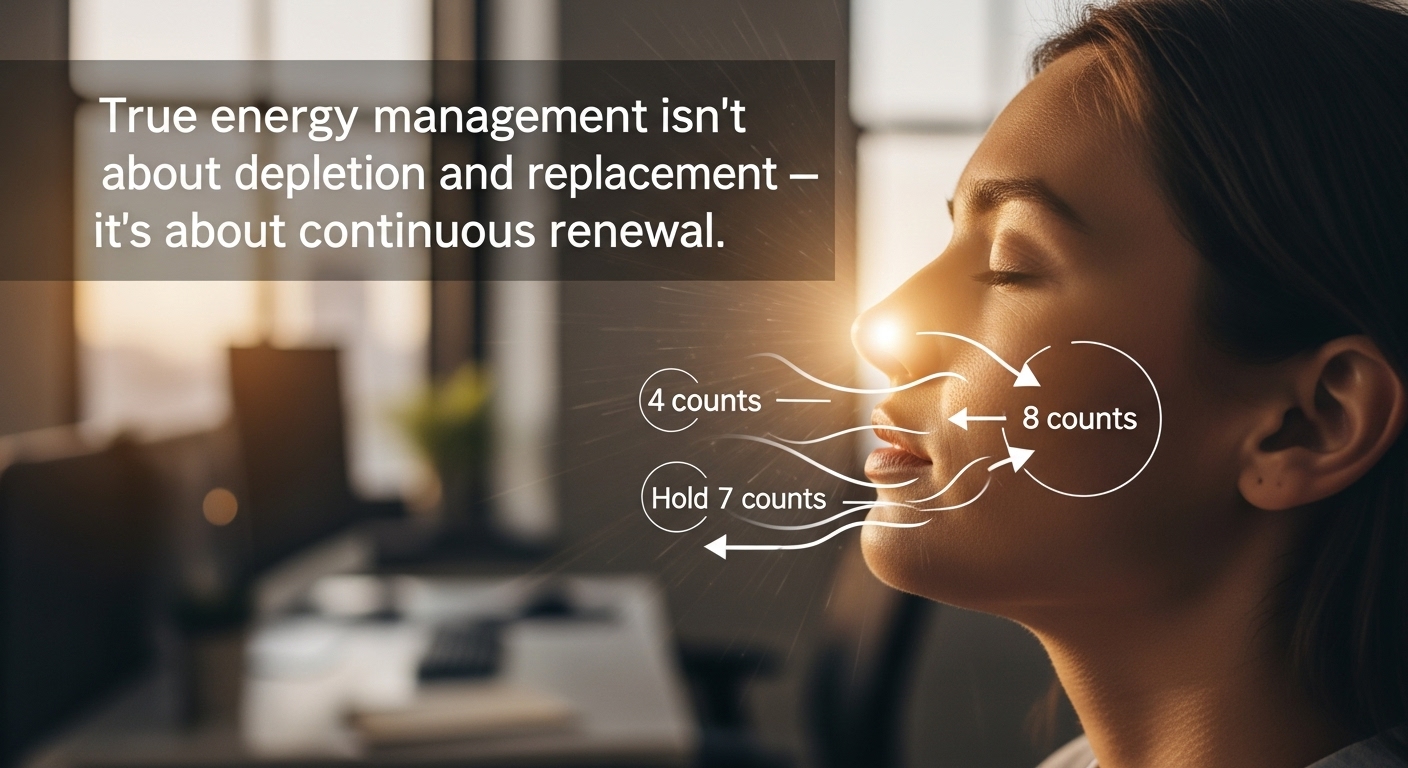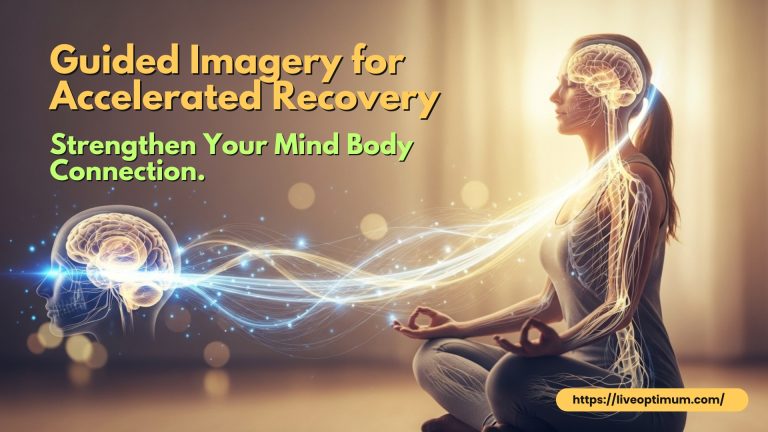Discover how a new mindset through intentional breathing can transform your energy levels. Learn 5 powerful breathing techniques that merge physical and mental transformation for peak performance.
Table of Contents
The Hidden Power Behind Every Breath.
Here’s something that’ll blow your mind: you take roughly 20,000 breaths every single day, yet most people never think about how they’re breathing. I used to be one of those people until I hit a wall so hard it changed everything.
Picture this, you’re crushing your morning workout, feeling invincible, then by 2 PM you’re dragging yourself through meetings like a zombie. That was my reality until I discovered something revolutionary about developing a new mindset around the most basic human function.
Your breath isn’t just keeping you alive, it’s the master key to unlocking sustained energy that most high performers never tap into. When you cultivate this new mindset around breathing, everything shifts. Your focus sharpens, your energy stabilizes, and suddenly you’re operating from a completely different level.
Studies show that conscious breathing can increase cognitive performance by up to 23% while reducing stress hormones by nearly 50%. This isn’t about becoming some zen master. This is about practical, game-changing techniques that require a fundamental new mindset shift to unlock their full potential.
The Foundation: From Shallow Survival to Deep Power
Most of us walk around taking tiny, shallow breaths that barely fill the top third of our lungs. It’s like trying to fuel a sports car with a garden hose. Your body’s constantly operating in low-level stress mode, and you don’t even realize how much this undermines your new mindset development.
The foundation starts with understanding that your breath is your most powerful tool for energy regulation. When you breathe shallow, you’re telling your nervous system “we’re in survival mode.” But when you breathe deep and intentional with this new mindset? That’s when the magic happens.
Here’s what changed everything: I started paying attention to how I breathed during different parts of my day. During stressful meetings, my breathing got super shallow. When I was relaxed, it naturally deepened. That’s when it clicked, I could actually control my energy state just by changing how I breathed with intentional new mindset practices.
The deep power breath technique is simple: breathe in for 4 counts through your nose, hold for 2, then exhale for 6 counts through your mouth. Do this for 2 minutes, and you’ll feel the shift immediately.
You know that feeling when you’re constantly putting out fires at work, never getting ahead? That’s exactly what shallow breathing does to your nervous system. I used to live in this perpetual state of barely keeping up. Then I realized something profound, just like in weightlifting where you need to engage your core before every heavy lift, you need to establish your breathing foundation before tackling challenges. When I started treating each deep breath like setting my stance for a heavy deadlift, suddenly I had the stability to handle whatever life threw at me.
Your breath is your foundation, everything else builds from there.
New Mindset Shift 1: The Energy Reset Breath
This one’s a game-changer when you hit that afternoon energy crash. I call it the Energy Reset Breath, and it’s become my secret weapon for maintaining the new mindset of sustained energy all day long.
Most people reach for caffeine when their energy dips, but that’s just borrowing energy from your future self. The Energy Reset Breath actually generates sustainable energy from within, perfectly aligning with a new mindset of self-reliance.
The technique uses a 4-7-8 pattern: inhale through your nose for 4 counts, hold for 7 counts, then exhale forcefully through your mouth for 8 counts. The key is that forceful exhale, you’re literally pushing out stagnant energy and making space for fresh vitality.

I discovered this during one of my most challenging work periods. Deadlines were crushing me, and I was downing coffee like it was water. My sleep was garbage, my workouts suffered, and I felt like I was running on empty constantly. That’s when I knew I needed a complete new mindset around energy management.
The first time I tried this with the new mindset approach, I was skeptical. But within three cycles, I felt this incredible surge of clarity and alertness that was completely different from caffeine jitters.
Now I use it religiously at 2 PM every day. Instead of reaching for that third cup of coffee, I spend 3 minutes doing Energy Reset Breathing with my new mindset focus.
Ever notice how some people seem to have endless energy while others burn out by lunch? I used to be the burnout type, constantly oscillating between pushing too hard and crashing completely. The Energy Reset Breath taught me something crucial, just like how proper rest between sets actually makes you stronger, intentional energy resets throughout the day compound your overall capacity. I was treating my energy like a finite resource instead of something that could be actively regenerated.
True energy management isn’t about depletion and replacement, it’s about continuous renewal.
Shift 2: The Focus Lock Pattern.
Your new mindset around breathing can be the difference between scattered productivity and laser focus. The Focus Lock pattern follows a box breath structure: 4 counts in, 4 counts hold, 4 counts out, 4 counts hold.
But here’s the secret sauce with this new mindset approach, you visualize locking in your attention with each cycle. On the inhale, you’re gathering focus. On the first hold, you’re centering it. On the exhale, you’re releasing distractions. On the final hold, you’re locking in your target.
I remember when I really needed this new mindset technique. I had a massive presentation to prepare, and my brain felt like a browser with 47 tabs open. Everything seemed urgent, nothing felt clear, and I was spinning my wheels.
Instead of forcing myself to power through the mental fog, I tried the Focus Lock breathing with this new mindset of intentional attention management. Within five cycles, something shifted. The mental chatter quieted down, and I could actually see the structure of what I needed to create.
This whole process takes less than 2 minutes, but the focused state can last for hours when you maintain this new mindset approach.

You know that feeling when you’re trying to have a serious conversation in a crowded restaurant? Your attention keeps getting pulled away by random noise. That’s exactly what happens in your mind without a focus protocol. I spent years thinking I just had a “busy mind.” Then I realized something from weight training, when you’re about to attempt a heavy lift, you don’t just grab the bar. You set your grip, engage your lats, take your breath, and create tension throughout your entire system.
Focus isn’t a trait you have or don’t have, it’s a state you systematically enter.
Shift 3: The Stress Transformer.
Developing a new mindset around stress changes everything. Stress isn’t inherently bad; it’s neutral energy that can either destroy you or fuel incredible performance when approached with the right new mindset.
The Stress Transformer is about converting stress energy into usable power instead of letting it eat you alive. This isn’t about eliminating stress but transforming it into your competitive advantage through a revolutionary new mindset shift.
The pattern is simple: 6 counts in through the nose, 2 count pause, 8 counts out through the mouth, 2 count pause. The magic happens in how you frame each phase mentally with this new mindset approach.
Read other articles from our “MIND-BODY INTEGRATION” category.
During the inhale, you’re not fighting the stress. You’re welcoming it, acknowledging it as energy. In the first pause, you’re choosing how to direct that energy with your new mindset. The long exhale transforms it from chaotic anxiety into focused determination.
I learned this during a particularly intense period when everything seemed to be falling apart at once. Work was brutal, personal stuff was messy, and I felt like I was drowning until I discovered this transformative new mindset approach.
My old approach was to either suppress the stress or let it completely take over. Neither worked. The Stress Transformer gave me a third option, partnership with stress instead of warfare against it, embodying a completely new mindset around pressure.

Remember learning to drive? At first, every little thing felt overwhelming. The stress response wanted to either freeze up or floor it. But experienced drivers don’t eliminate the alertness that comes with driving; they channel it into smooth, confident control. I used to treat stress like a malfunction proving I wasn’t cut out for high-pressure situations. But elite athletes taught me something crucial, they’re not stress-free, they’re stress-fluent.
Stress isn’t your enemy trying to break you, it’s your sparring partner trying to make you stronger.
Shift 4: The Recovery Accelerator.
Most high-performers are garbage at recovery. We’re great at pushing, terrible at restoration. But developing a new mindset around breathing taught me that active recovery isn’t just helpful, it’s essential for sustained high performance.
The Recovery Accelerator isn’t about checking out. It’s about intentionally shifting your nervous system from sympathetic overdrive into parasympathetic restoration while maintaining mental clarity through this powerful new mindset approach.
The technique uses a 3-6-9 pattern: 3 counts in, 6 counts hold, 9 counts out. The extended exhale is crucial, it’s like pressing the reset button on your entire nervous system. But here’s the key insight with this new mindset: you’re not trying to become sleepy. You’re creating optimal conditions for cellular recovery while keeping your mind sharp.
I discovered this when I was training hard, working intense hours, and basically running myself into the ground. I thought recovery meant collapsing on the couch with Netflix, but that just left me feeling drained until I adopted this new mindset around intentional restoration.
READ OUR NEWEST ARTICLE
“Mind Clarity: 7 Rare Weightlifting Secrets for Peak Performance.”
Instead of passive recovery, I started practicing active restoration with this new mindset focus. Fifteen minutes of this breathing pattern, and I’d feel genuinely refreshed instead of just temporarily distracted.
You know how some people can work out intensely every day while others need three days off after one hard session? The difference isn’t just genetics, it’s recovery efficiency. I used to think recovery meant doing nothing. But professional athletes don’t just stop training; they actively facilitate restoration through specific protocols. The Recovery Accelerator became my equivalent of an athlete’s ice bath.
Recovery isn’t the absence of effort, it’s the intentional practice of renewal.
Shift 5: The Peak State Activator.
This is where everything comes together with your new mindset mastery. The Peak State Activator uses your developed breathing skills to access your highest level of performance on demand.
Most people think peak states just happen randomly. But that’s amateur thinking. Peak states can be systematically created through specific breathing protocols when you maintain this new mindset of intentional state management.
The Peak State Activator uses variable rhythm breathing: 2 quick inhales through the nose, 1 long exhale through the mouth, repeated in sets of 10. This activates your sympathetic nervous system while maintaining control through your cultivated new mindset.
Between each set, you take one deep, grounding breath using the 4-6-8 pattern. This keeps you from getting amped up without direction through your disciplined new mindset approach. You’re building controlled intensity.
I developed this during my most challenging professional period. I had a presentation that could make or break a major opportunity, and I needed to show up at my absolute best with a completely new mindset around performance pressure.
The traditional advice of “just relax” felt completely wrong. I didn’t need to be relaxed, I needed to be powerful, clear, and dynamic. The Peak State Activator with this performance-focused new mindset gave me exactly that.

Ever watch a sprinter right before a race? They’re not trying to be calm and relaxed. They’re systematically building controlled intensity, like a sports car revving at the starting line. I used to think peak performance meant being “zen” all the time, but that’s like trying to deadlift your max weight while half asleep. The Peak State Activator taught me the difference between calm confidence and peak readiness.
Peak performance isn’t about being relaxed, it’s about being completely activated with total control.
Integration: Making Your New Mindset Stick.
Here’s where most people mess up, they try to do everything at once and end up doing nothing consistently. A sustainable new mindset requires gradual integration, not perfect execution from day one.
Start with one technique that resonates most with your current challenge. Struggling with afternoon crashes? Master the Energy Reset Breath first with focused new mindset development. Can’t focus during deep work? The Focus Lock becomes your priority for building this new mindset foundation.
Spend a full week practicing just one technique with dedicated new mindset commitment. Set reminders, attach it to existing habits, whatever it takes to make it automatic. Only after one technique feels natural do you add the next one to your expanding new mindset toolkit.
Your new mindset around breathing becomes the foundation for all other performance improvements. These aren’t just techniques, they’re pathways to a completely different way of operating.
Conclusion: Your New Operating System
Developing a new mindset around breathing isn’t just about learning techniques, it’s about upgrading your entire operating system for life. When you master these five breathing shifts with your cultivated new mindset, you’re fundamentally changing how you interface with challenge, pressure, and opportunity.
The Energy Reset becomes your afternoon superpower through this new mindset approach. The Focus Lock transforms scattered productivity into laser execution. The Stress Transformer converts pressure into competitive advantage with your revolutionary new mindset. The Recovery Accelerator ensures you’re building capacity instead of burning out. The Peak State Activator gives you on-demand access to your highest performance.
But here’s what really excites me about this new mindset, it’s just the beginning. Once you experience the power of conscious breathing, you start seeing connections everywhere. That’s exactly what we’ll explore in the next article: “The Sleep-Energy Connection: How Your Night Routine Amplifies Daytime Power.”
Your journey toward hybrid physical and mental mastery doesn’t end with this new mindset around breathing, it begins there. Start with your breath. Master your energy. Transform your life through this powerful new mindset approach.
TOP 15 FAQ
-
What is a new mindset?
A new mindset is a shift in how you approach challenges, energy, and growth. Instead of running on autopilot with shallow habits like rushed breathing or constant stress, it’s about intentionally creating focus, stability, and resilience. For example, using conscious breathing as a tool to manage energy is a way to practice this new mindset.
-
Is “Mindset” worth reading?
Yes, Carol Dweck’s Mindset is highly regarded for introducing the growth vs. fixed mindset concept. It lays a foundation that pairs well with practical techniques, like intentional breathing, which can help you apply those theories in daily performance and recovery.
-
What are the 4 pillars of mindset?
The four core pillars often referenced are: growth, resilience, focus, and adaptability. In practice, these pillars show up when you build habits like breathwork, helping you stay present, manage stress, recover effectively, and activate peak states when needed.
-
What is the new thought mindset?
The new thought mindset is the belief that your thoughts directly influence your outcomes. In the context of breathing, it means recognizing that how you breathe doesn’t just reflect your state, it can transform it, creating energy, focus, or calm depending on your intention.
-
New mindset quotes
One powerful way to express it is:
“Your breath is your foundation, everything else builds from there.”
Another is:
‘Peak performance isn’t about being relaxed, it’s about being completely activated with total control.”
These reflect how a new mindset is both practical and transformative. -
New mindset meaning
The meaning of a new mindset is upgrading your “operating system.” Instead of letting stress or fatigue control you, you adopt deliberate practices, like the Energy Reset Breath or Stress Transformer, that turn challenges into fuel for growth.
-
Mindset: The New Psychology of Success reviews
Most reviews highlight how the book helps people recognize their self-limiting beliefs and shift toward a growth perspective. Readers find it valuable in education, career, and performance contexts. Paired with daily techniques like mindful breathing, the lessons become even more actionable.
-
Synopsis of Mindset: The New Psychology of Success
Carol Dweck explains the difference between a fixed mindset, believing abilities are static and a growth mindset, believing they can be developed. Success, she argues, comes from embracing challenges, learning from setbacks, and adapting. This aligns with training methods where breathwork helps unlock growth.
-
How does breathing support a new mindset?
Breathing acts as the physical foundation of mindset work. Shallow breathing keeps you stuck in survival mode, while deep, intentional patterns signal your body to reset energy, focus, and stress. It’s the simplest way to shift into a new mindset in real time.
-
What is the Energy Reset Breath?
It’s a 4-7-8 pattern where you inhale for 4 counts, hold for 7, and exhale forcefully for 8. Unlike caffeine, which temporarily spikes energy, this technique sustainably clears mental fog and regenerates energy, perfect for mid-day crashes.
-
Can a new mindset reduce stress?
Yes. With techniques like the Stress Transformer Breath, stress isn’t seen as a threat but as energy you can channel. This mindset shift prevents burnout and helps turn pressure into performance fuel.
-
How do you create focus with a new mindset?
Using methods like the Focus Lock Breath (box breathing), you systematically gather, center, and lock in attention. Instead of letting distractions scatter your energy, you train your mind to enter a focused state on command.
-
What role does recovery play in a new mindset?
Recovery is not passive rest but active renewal. With the Recovery Accelerator Breath (3-6-9 pattern), you deliberately slow your nervous system while staying sharp, making it easier to bounce back stronger instead of just collapsing into fatigue.
-
How do you activate peak performance with a new mindset?
Peak states don’t happen randomly, they’re trained. The Peak State Activator (two quick inhales, one long exhale) helps build controlled intensity, much like athletes do before competition. It’s a repeatable process, not luck.
-
How do you integrate a new mindset into daily life?
Start small by choosing one breathing technique that fits your biggest challenge fatigue, stress or focus. Practice it daily until it becomes natural. From there, layer in other shifts. Over time, the consistent application turns your “new mindset” into your default mode of operating.






